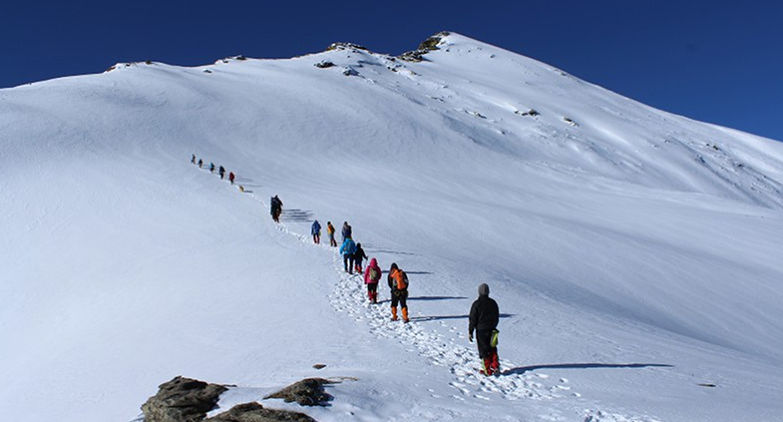Overview
The Kedarkantha Trek is one of the classic Himalayan winter hikes. When it comes to winter trekking in India, the Kedarkantha trip may be the finest option. The view of the Mighty Himalayas from the paths all the way to the summit, which is at an altitude of 3,810 meters/12,500 feet, is particularly stunning with the falling winter snow. This journey, regardless of expertise, is suggested for all adventure spirits who enjoy snow and High Mountains. Beginners are invited to participate in this lovely hike.
One of the reasons for the Kedarkantha trek’s popularity is the ascent to the peak. The paths of Kedarkantha combine all the subtleties and challenges of a summit trip, but on a much smaller scale, starting in the wee hours of the morning in freezing temperatures, with lights lighting the route beneath a breaking dawn.
Difficulty of Kedarkantha Trek
The Kedarkantha trek, which spans 20 kilometres over five days, is appropriate for first-time hikers due to the short distances to be covered each day. The trip starts at Sankri village, which is a popular starting place for numerous Uttarakhand hikes.
This walk includes some of the most magnificent campsites in the Himalayas, each of which is unique in its own way and does not compare in beauty to any of the other campsites along the way. This mountain is easily accessible at any time of year and provides hikers with a distinct peaceful experience depending on the season. Finally, the route leads to the best point of rocky snow-covered top, from where hikers may enjoy spectacular 360-degree views of the DhaulaDhar ranges and Godly peaks such as Swargarohini, Banderpooch, and Black Peak.
The ascent is not simple. The gradient is consistent throughout the stretch. It becomes more difficult as you approach the peak. The huge mountains of the higher Himalayas, on the other hand, will keep you company until you reach the top. You experience a great feeling of pleasure and achievement as you stretch and take in the sights of the Himalayas from the peak. This is a sensation unlike any other. Few treks have the same level of adventure, therefore it’s popular with novices for its best summit climb. The trip is particularly notable for its lovely clearings outside of the peak. On a trip, you’ll seldom come across gorgeous clearings that provide rest stops and excellent campsites.
Best time to do Kedarkantha trek
The Kedarkantha trek is one of the few in the Indian Himalayas that may be done throughout the year. Except for July and August, the Kedarkantha trip is open for 10 months of the year (the peak rainy months in Uttarakhand).
Winter – December to February
Spring – March and April
Summer – May and June
Autumn – Mid September to November
Kedarkantha is most well-known as a winter trip, and for good reason. The breathtaking scenery and challenging peak ascent, especially in the winter, may leave anyone weak in the knees. Kedarkantha is an excellent winter hike, particularly for novices. What makes it ideal is the way it balances beauty with adventure in the proper proportions. You will be trekking through thick, snow-covered woodlands. You’ll learn to set up camp in clearings amidst heavy snowdrifts. With a thick layer of snow all the way to the peak, the summit ascent will have your pulse pumping. Even experienced trekkers will find the winter trip to be a remarkable and unique experience.
Kedarkantha in Winter
Fresh snowfall, heavy snowfall, chilly days, and severely cold nights characterize the winter season. Snowfall generally begins around the end of December and lasts until mid-February. Daytime temperatures will be about 8-10° C, but nighttime temperatures will be below zero. On certain days, the temperature drops below -5° C. This season, especially in the upper campgrounds, you may find it rather chilly to hike in. However, with the appropriate equipment, anyone can go on a winter hike. You’ll have a better chance of enjoying the trip in the winter snow if you bundle up from top to bottom.
Kedarkantha in Spring
Flowers bloom in the spring, contrasting with melting snow at higher elevations and carpeted meadows and woods at lower elevations. The sun will shine brighter, the days will get longer, and the nights will become warmer. There will be no new snowfall. Temperatures will range between 15 and 18 degrees Celsius during the day, and 0 to 5 degrees Celsius at night. If you want to see a decent combination of foliage and snow, this is the time to go.
Kedarkantha in Summer
You may expect bright sunny days and somewhat cooler nights during the summer. So, if you’re wanting to go on a hike in pleasant weather, now is the time. Temperatures will range from 18 to 24 degrees Celsius during the day, and 3 to 8 degrees Celsius at night. Mild rains are expected to begin towards the end of the summer. Rainstorms generally begin in the afternoon and last into the evening. The monsoon season will officially begin on this date.
Kedarkantha in Monsoon
The Monsoon season is difficult to trek during since it is when there is a risk of continuous rain and lightning, two major risks to be aware of. As a result, we recommend skipping this walk during the rainy season. Check out our monsoon treks if you’re searching for a trip from July to September. This is when Kashmir (Great Lakes of Kashmir, Tarsar Marsar) and Himachal (Hampta Pass, Bhrigu Lake, Beas Kund, Pin Bhaba Pass) open out and transport you to another planet.












